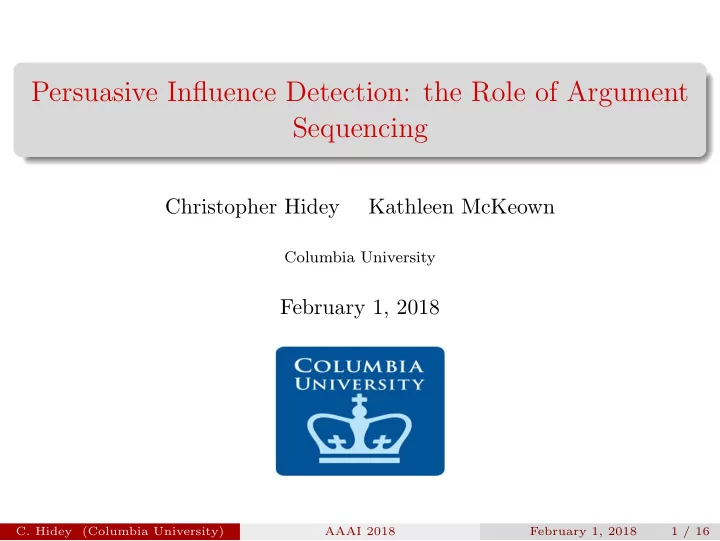

Persuasive Influence Detection: the Role of Argument Sequencing Christopher Hidey Kathleen McKeown Columbia University February 1, 2018 C. Hidey (Columbia University) AAAI 2018 February 1, 2018 1 / 16
Persuasion Research questions : Can we leverage sequential aspects of social media posts for persuasiveness prediction? How do humans perform at identifying personalized persuasion? C. Hidey (Columbia University) AAAI 2018 February 1, 2018 2 / 16
Introduction 1 Introduction 2 Data 3 Methods 4 Results 5 Error Analysis C. Hidey (Columbia University) AAAI 2018 February 1, 2018 3 / 16
Previous Work Tan et al. (2016); Wei et al. (2016) - predicting persuasiveness/ranking comments in Change my View Rosenthal and McKeown (2017) - identifying influencers in social media Stab and Gurevych (2016) - objectively ranking convincingness of arguments C. Hidey (Columbia University) AAAI 2018 February 1, 2018 4 / 16
Data CMV: Patriotism is the belief that being born on one side of a line makes you bet- OP ter... I would define patriotism quite simply as supporting one’s country, but not *neces- sarily* disparaging others... R Someone who assists another country that is in worse shape instead of assisting their own can still be a patriot, but also recognize significant need in other nations and decide to assist them as well This is true, but, I think, supporting the common good is also more important OP than supporting your country Yes, but the two are often one the same, especially when you live in a country as large as the U.S. most acts which serve the common good generally support your R country. I see. They’re not mutually exclusive so I think I had the wrong definition: ∆ OP Overall: 5296 positive, 16685 negative C. Hidey (Columbia University) AAAI 2018 February 1, 2018 5 / 16
Persuasion Research questions : Can we leverage sequential aspects of social media posts for persuasiveness prediction? How do humans perform at identifying personalized persuasion? C. Hidey (Columbia University) AAAI 2018 February 1, 2018 6 / 16
Methods Deep Learning for predicting persuasion: MLP ( h ) + β T φ � � y = σ h - learned document representation (our contribution) φ - additional document features (Tan et al., 2016) Interplay - intersection of words between OP and response Patriotism is the belief that ... I would define patriotism as ... MLP , β - learned weights C. Hidey (Columbia University) AAAI 2018 February 1, 2018 7 / 16
Methods h - the initial document representation C. Hidey (Columbia University) AAAI 2018 February 1, 2018 8 / 16
Methods h - the complete document representation C. Hidey (Columbia University) AAAI 2018 February 1, 2018 9 / 16
Results Influence - predict whether a post is persuasive or not Model Acc. AUC F1 Bag of Words 61.9 72.8 50.3 R MLP 68.8 73.2 50.3 LSTM 75.1 75.5 53.0 Interplay 72.7 76.7 54.6 LSTM+Memory 74.3 77.3 55.4 OP LSTM+Memory+Interplay 81.0 82.1 60.7 Table 1: Results of Influence Prediction Task Interplay - intersection of words between original post and response MLP - sentence vectors from word, frame, discourse embeddings LSTM - over sentence vectors from word, frame, discourse embeddings C. Hidey (Columbia University) AAAI 2018 February 1, 2018 10 / 16
Persuasion Research questions : Can we leverage sequential aspects of social media posts for persuasiveness prediction? How do humans perform at identifying personalized persuasion? C. Hidey (Columbia University) AAAI 2018 February 1, 2018 11 / 16
Crowdsourcing Experiment 200 original posts paired with positive and negative arguments 3 questions: Would the original poster find the first/second argument convincing? How would the OP rank the arguments? Required to provide a justification of 20 words for each of the 3 questions Yes, because I feel that the argument A coincides more with the original post, referring to the motivation that some inhabitants have to vote Model Pairwise Influence Annotators 54.84 57.14 Model 71.99 63.00 Table 2: Human Performance C. Hidey (Columbia University) AAAI 2018 February 1, 2018 12 / 16
Error Analysis Human Model Category % P I P I Government 29 55.1 64.4 58.5 76.3 Sociology 23 71.7 53.3 80.4 68.5 Morality 11 72.7 63.6 77.3 68.2 Economics 9 50.0 50.0 72.2 58.3 Politics 8 62.5 56.3 68.8 62.5 Science 6 66.6 66.6 66.6 62.5 Culture 5.5 54.5 45.5 54.5 63.6 Table 3: Error Analysis on Categorized Data Humans do better at tasks requiring world knowledge (government) C. Hidey (Columbia University) AAAI 2018 February 1, 2018 13 / 16
Error Analysis Weinberg was wrong when he said that “for good people to do evil things, that OP takes religion” I think that someone isn’t a good person if they have an ideology I disagree with R I think nationalists are bad, fascists are bad and so on ( Gold: Negative Predicted: Negative) Countries should have a “no confidence” vote in elections if they want to increase turnout, while achieving a better understanding of the public’s perception of the OP political climate The US state of Nevada has had a choice called “none of these candidates” since R 1975 ( Gold: Positive Predicted: Negative) C. Hidey (Columbia University) AAAI 2018 February 1, 2018 14 / 16
Conclusions Modeling argument sequencing and context helps Humans are poor judges of personalized persuasiveness Future models would benefit from world knowledge and reasoning C. Hidey (Columbia University) AAAI 2018 February 1, 2018 15 / 16
Questions ? Thanks to DARPA-DEFT and all the annotators! C. Hidey (Columbia University) AAAI 2018 February 1, 2018 16 / 16
Recommend
More recommend